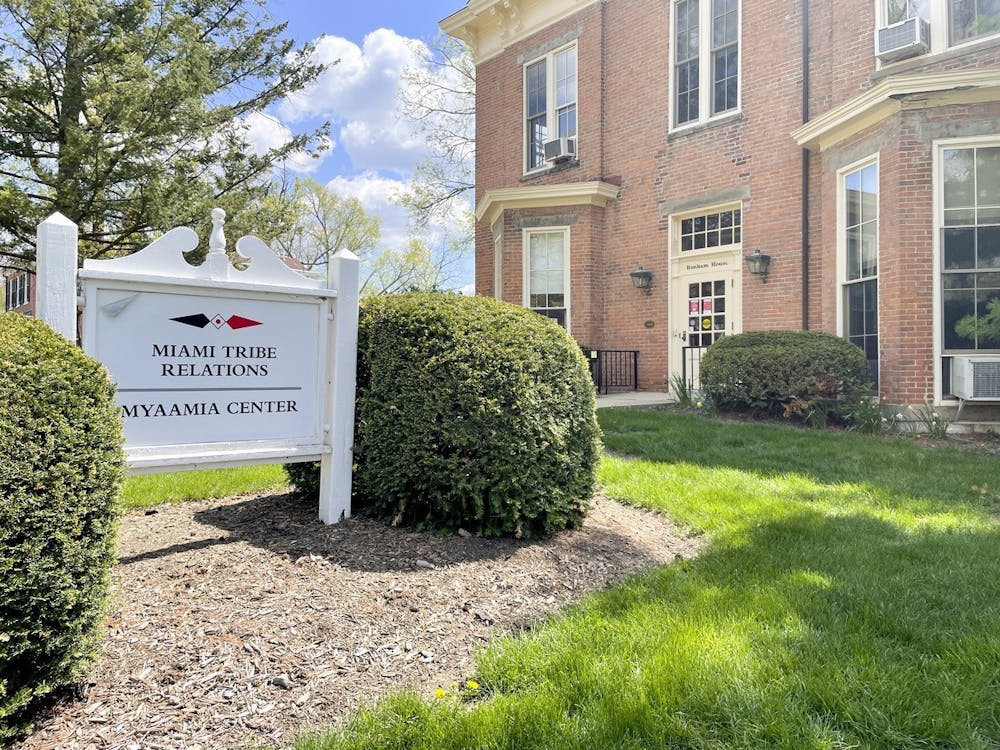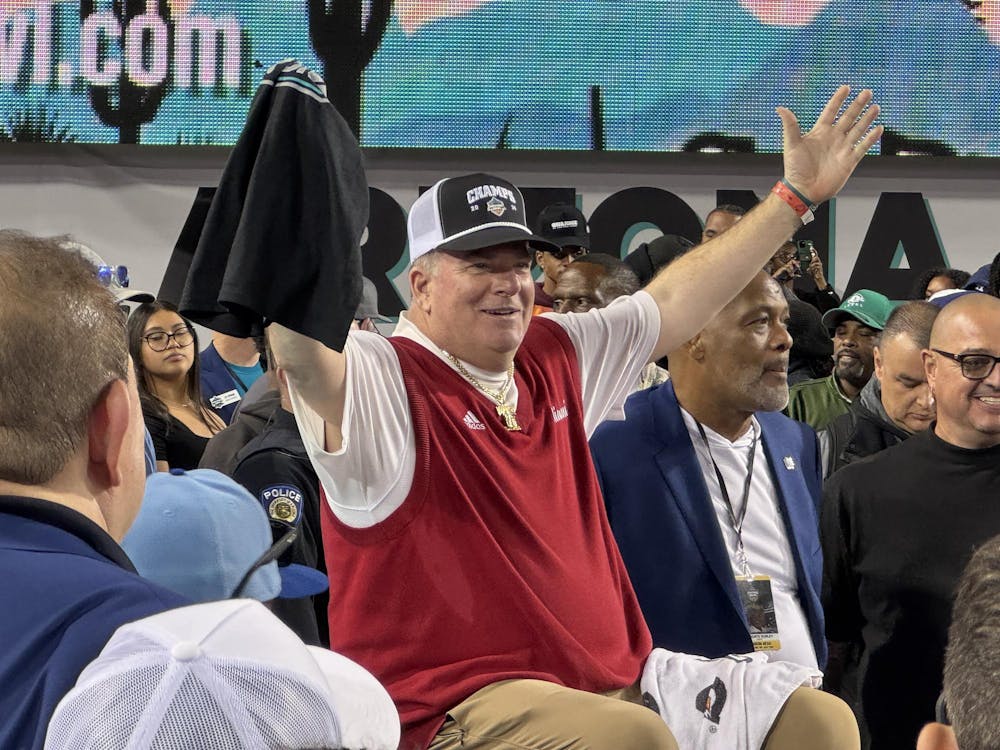In 1972, Forest Olds, then chief of the Miami Tribe of Oklahoma, visited Miami University, laying the grounds for a relationship with the name-sharing university. This year, the tribe and university’s relationship turned 50, and the partnership has grown since Olds’ visit to include a dedicated center at the university.
A brief history of the Miami Tribe
The Myaamiaki “Miami people” first came in contact with Europeans in 1665 when Nicolas Perrot met them in a shared southern Wisconsin village with the Inohka (Illinois), Kickapoo and Mascouten tribes.
Bert Anson, author of “The Miami Indians,” writes that the tribe had no legends about migration before the 1700s, which was emphasized by a frequently repeated statement from Little Turtle, a Myaamiaki war chief in the late 1700s.
“My fathers kindled the first fire at Detroit; thence they extended their lines to the headwaters of the Scioto; thence to its mouth; thence down the Ohio to the mouth of the Wabash and thence to Chicago over Lake Michigan,” Little Turtle would say.
Despite cold from the surrounding lakes, the Myaamiaki typically wore only skin shirts, leggings and moccasins which allowed them to display their tattoos. They grew soft white corn, melons, squash and beans, and they would celebrate their harvests with dancing, games and music.
At the beginning of the 16th century, the Myaamiaki moved east and would continue to migrate throughout the Great Lakes region to different river valleys until the early 1800s, when the tribe was in its homelands of the Wabash River Valley.
In 1830, Congress passed the Indian Removal Act, forcibly removing Native American tribes from their homelands to areas west of the Mississippi River.
The Myaamiaki were not so willing to move after having settled in the Wabash River Valley. In an 1840 treaty ratified by the Senate, the tribe agreed to move within five years.
The treaty, however, did not go according to plan, and the tribe did not move in the timespan. Anson wrote that dispersed members refused to assemble, and the tribe’s debts in the region had not been paid.
In June 1846, Chief Francis La Fontaine met with President James Polk at the White House to appeal the delay from 1845.
The appeal was denied.
Enjoy what you're reading?
Signup for our newsletter
The tribe was forced to begin emigration on Oct. 6, 1846, starting at Peru, Indianapolis, and traveling by river to Kanza Landing in today’s Kansas City, Missouri, on Nov. 1, 1846. The tribe then traveled 50 miles on land to a reservation in Kansas.
In 1867, the tribe was once again moved, this time to Indian Territory in Oklahoma, where the tribe still resides, going by the Miami Tribe of Oklahoma, deriving from the Myaamia name. The tribe’s current chief is Douglas Lankford.
neepwaantiinki: Miami, the tribe, and Miami, the university
Miami University was founded in 1809 in the Miami Valley, a term referring to the lands surrounding the Miami River. The region draws its name from the Miami Tribe’s time in the area, which William Kubiak, author of “Great Lakes Indians: a pictorial guide,” estimates to have been from 1720 to 1763.
The university did not have a prominent relationship with the tribe from which its name comes until Chief Olds’ visit in 1972.
One of the first steps Miami took to maintain this relationship was creating a scholarship program hoping to help Miami Tribe members attend the university.
In February of 1974, Miami released a description of the scholarship, which was preferred to be given to a Native American, particularly of the Miami Tribe. The scholarship would cover the costs of college not already covered by financial aid.
The university gave the scholarship information to the Miami Tribe, which shared it with other Oklahoma tribes. However, no Native Americans applied for the scholarship until 1978, when a member of the Wampanoag Tribe from Massachusetts became the first to receive the scholarship.
In 1990, Myrtis Powell, who was the vice president for student affairs, sent a letter to Miami’s Chief Floyd Leonard, promising to provide tuition waivers to any Miami Tribe members who were accepted to the university. The waiver became part of the Myaamia Heritage Award Program, and the first students enrolled for the 1991-92 academic year.
Currently, members of the program are also required to take one-credit Heritage courses spread across eight semesters, which focus on themes about the Miami Tribe.
“The Heritage class meets weekly, providing an opportunity for Myaamia students to maintain their connection with one another,” the program’s website says. “Although the total membership of the Miami Tribe community is small (around 6,000 people) and dispersed throughout the U.S., Heritage classes allow Myaamia students to learn about the ways in which they are related to each other and develop a small Tribal community on campus.”
According to the Miami Tribe Relations website, more than 100 Myaamia students have graduated from the university since 1991, with a 92% graduation rate for the program.
In 2001, Miami Tribal leaders’ interests in language and cultural education grew. They prompted the university to create the Myaamia Project, led by Daryl Baldwin, a member of the Miami Tribe.
With its success, the project became the Myaamia Center in 2013. The center is located on campus at Bonham House and focuses on research, which it presents every other year at the Myaamiaki Conference, the most recent one held on April 9, 2022.
The university uses the term neepwaantiinki, which means “learning from each other,” to describe its relationship with the tribe.
In 2017, Miami introduced a Myaamia Heritage Logo, which symbolizes the tribe’s relationship with the university. The university has also created a land acknowledgement, honoring the traditional homelands of the Myaamia people, along with the Shawnee people, which were ceded to the U.S. in 1975 with the Treaty of Greeneville.
Currently, Miami’s King Library has an exhibit about Myaamiaki on display in the Walter Havighurst Special Collections on the third floor of the library. The exhibit is open from 8 a.m. to 5 p.m. Mondays through Fridays.
On Oct. 21, Baldwin attended an event where people could talk to the curators of the exhibition. During the event, Baldwin expressed joy with the university’s relationship with the tribe.
“Nobody could’ve imagined that it would grow into what it is today,” Baldwin said.




